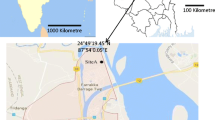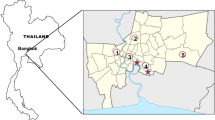Abstract
Airborne fungal spores are well documented to trigger respiratory allergy. The present study provides baseline information on the quantitative and qualitative aspects of aerospores for the first time in a typical urban area of Kolkata metropolis, India. An aeromonitoring was performed by Burkard volumetric 7-day sampler for two consecutive years (August 2012–July 2014). Total concentration, seasonal variations and intradiurnal periodicities of fungal spores were estimated. Spearman’s rank correlation analysis was performed using various weather parameters. The prevalence of fungal spore allergy was investigated among patients reporting to the Department of Allergy and Asthma, Mediland Diagnostics, Kolkata. A retrospective review of patients was conducted with a standard questionnaire and performing skin prick test with 20 fungal extracts. Thirty-eight fungal genera were identified with the highest spore concentration in August. Relative humidity and rainfall were found to be positively correlated with spore concentration. A comparatively higher frequency of sufferers was observed for males and 15–35-year age group. Patients with an atopic family history and insidious onset of symptoms were prone to suffer more, and bronchial asthma was diagnosed in most. Out of 742 patients, 592 patients noticed to have positive skin reactivity toward one or more fungal extracts. Aspergillus fumigatus followed by Curvularia pallescens and Fusarium lateritium elicited maximum sensitization. Each of these genera also represented a considerable fraction of the total aeromycota, thereby indicating potential risk to the sensitized individuals. Further serological analysis along with the identification of fungal allergens would pave the way of immunotherapy.




Similar content being viewed by others
References
Babu, C. R., Singh, A. B., & Shivpuri, D. N. (1979). Allergenic factors and symptomatology of respiratory allergy patients. Journal of Asthma Research, 16(3), 97–101.
Bavbek, S., Erkekol, F. O., Ceter, T., Mungan, D., Ozer, F., Pinar, M., et al. (2006). Sensitization to Alternaria and Cladosporium in patients with respiratory allergy and outdoor counts of mold spores in Ankara atmosphere, Turkey. Journal of Asthma, 43(6), 421–426.
Burge, H. A. (2002). An update on pollen and fungal spore aerobiology. Journal of Allergy and Clinical Immunology, 110(4), 544–552.
Burge, H. A., & Rogers, C. A. (2000). Outdoor allergens. Environmental Health Perspectives, 108, 653–659.
Chakrabarti, H. S., Das, S., & Gupta-Bhattacharya, S. (2012). Outdoor airborne fungal spora load in a suburb of Kolkata, India: Its variation, meteorological determinants and health impact. International Journal of Environmental Health Research, 22(1), 37–50.
Chakraborty, P., Gupta-Bhattacharya, S., & Chanda, S. (2003). Aeromycoflora of an agricultural farm in West Bengal, India: A five-year study (1994–1999). Grana, 42(4), 248–254.
Cho, S., Seo, S., Schmechel, D., Grinshpun, S. A., & Reponen, T. (2005). Aerodynamic characteristics and respiratory deposition of fungal fragments. Atmospheric Environment, 39, 5454–5465.
Crameri, R., Garbani, M., Rhyner, C., & Huitema, C. (2014). Fungi: The neglected allergenic sources. Allergy, 69(2), 176–185.
Dales, R. E., Cakmak, S., Judek, S., Dann, T., Coates, F., Brook, J. R., et al. (2004). Influence of outdoor aeroallergens on hospitalization for asthma in Canada. Journal of Allergy and Clinical Immunology, 113(2), 303–306.
Das, S., & Gupta-Bhattacharya, S. (2008). Enumerating outdoor aeromycota in suburban West Bengal, India, with reference to respiratory allergy and meteorological factors. Annals of Agricultural and Environmental Medicine, 15(1), 105–112.
Dey, D., Ghosh, N., Pandey, N., & Gupta Bhattacharya, S. (2014). A hospital-based survey on food allergy in the population of Kolkata, India. International Archives of Allergy Immunology, 164, 218–221.
Dey, D., Saha, B., Sircar, G., Ghosal, K., & Bhattacharya, S. G. (2016). Mass spectrometry-based identification of allergens from Curvularia pallescens, a prevalent aerospore in India. Biochimica et Biophysica Acta, 1864, 869–879.
Erkara, I. P., Ilhan, S., & Oner, S. (2009). Monitoring and assessment of airborne cladosporium link and Alternaria Nées spores in Sivrihisar (Eskisehir), Turkey. Environmental Monitoring and Assessment, 148(1–4), 477–484.
Fukutomi, Y., & Taniguchi, M. (2015). Sensitization to fungal allergens: Resolved and unresolved issues. Allergology International, 64(4), 321–331.
Green, B. J., Tovey, E. R., Sercombe, J. K., Blachere, F. M., Beezhold, D. H., & Schmechel, D. (2006). Airborne fungal fragments and allergenicity. Medical Mycology, 44, S245–S255.
Gregory, P. H. (1973). The microbiology of the atmosphere (2nd ed.). London: L. Hill.
Grinn-Gofroń, A. (2008). The variation in spore concentrations of selected fungal taxa associated with weather conditions in Szczecin, Poland, 2004–2006. Grana, 47(2), 139–146.
Kasprzyk, I., Rzepowska, B., & Wasylów, M. (2004). Fungal spores in the atmosphere of Rzeszów (south-east Poland). Annals of Agricultural and Environmental Medicine, 11(2), 285–289.
Kauffman, H. F., Tomee, J. F., van de Riet, M. A., Timmerman, A. J., & Borger, P. (2000). Protease-dependent activation of epithelial cells by fungal allergens leads to morphologic changes and cytokine production. Journal of Allergy and Clinical Immunology, 105, 1185–1193.
Knutsen, A. P., Bush, R. K., Demain, J. G., Denning, D. W., Dixit, A., Fairs, A., et al. (2012). Fungi and allergic lower respiratory tract diseases. Journal of Allergy and Clinical Immunology., 129(2), 280–291.
Kurup, V. P., Shen, H. D., & Banerjee, B. (2000). Respiratory fungal allergy. Microbes and Infection, 2(9), 1101–1110.
Lim, S. H., Chew, F. T., Dali, S. D. B. M., Tan, H. T. W., Lee, B. W., & Tan, T. K. (2009). Outdoor airborne fungal spores in Singapore. Grana, 37, 246–252.
Luo, W. (1991). Deposition of large particles in the nose and mouth. Grana, 30, 79–81.
Mensah-Attipoe, J., Saari, S., Veijalainen, A. M., Pasanen, P., Keskinen, J., Leskinen, J. T., et al. (2016). Release and characteristics of fungal fragments in various conditions. Science of the Total Environment, 547, 234–243.
Moubasher, A. H. (1993). Soil fungi in Qatar and other Arab countries (Vol. 50(2), p. 242). Doha: University of Qatar, Center of Scientific and Applied Research.
Nilsson, S. (1983). Atlas of airborne fungal spores in Europe. Berlin: Springer.
Oliveira, M., Ribeiro, H., Delgado, J. L., & Abreu, I. (2009). Seasonal and intradiurnal variation of allergenic fungal spores in urban and rural areas of the North of Portugal. Aerobiologia, 25(2), 85–98.
Roby, R. R., & Sneller, M. R. (1979). Incidence of fungal spores at the homes of allergic patients in an agricultural community. II. Correlations of skin tests with mold frequency. Annals of Allergy, 43(5), 286–288.
Samson, R. A., Hoekstra, E. S., Feisvad, J. C., & Filtenborg, O. (2002). Introduction to food and airborne fungi. Utrecht: Centraalbureauvoor Schimmelcultures.
Shaheen, I. Y. (1989). Aerobiology—Fungal spores and pollen grain in north-western Amman. M.Sc. thesis, University of Jordan, Amman, Jordan.
Simon-Nobbe, B., Denk, U., Poll, V., Rid, R., & Breitenbach, M. (2008). The spectrum of fungal allergy. International Archives of Allergy and Immunology, 145(1), 58–86.
Stepalska, D., & Wołek, J. (2009). Intradiurnal periodicity of fungal spore concentrations (Alternaria, Botrytis, Cladosporium, Didymella, Ganoderma) in Cracow, Poland. Aerobiologia, 25, 333–340.
Stytis, D. P., Stobo, J. D., Fudenberg, H., & Wells, J. V. (1982). Basic and clinical immunology. Singapore: Lange Medical Publishers, Maruzen Asia (P) Ltd.
Taylor, P. E., Esch, R., Flagan, R. C., House, J., Tran, L., & Glovsky, M. M. (2006). Identification and possible disease mechanisms of an under-recognized fungus, Aureobasidium pullulans. International Archives of Allergy and Immunology, 139(1), 45–52.
Acknowledgements
This work is supported financially by University Grants Commission (Grant No. F.2-8/2002(SA-I)), Government of India. Authors are thankful to the Director, Bose Institute, Kolkata, for providing infrastructural facilities. The authors wish to express sincere gratitude to the medical professionals and clinical staffs of Mediland Diagnostics, Kolkata, for executing the clinical aspects. Sincere thanks to Chanchal Chakraborty, Soumya Subhra Gupta, Jadab Kumar Ghosh, Kaberi Ghosh and Asish Bera for technical help.
Author information
Authors and Affiliations
Corresponding author
Ethics declarations
Conflict of interest
The authors declare that they have no conflict of interest.
Ethical approval
All procedures performed in studies involving human participants were in accordance with the ethical standards of the clinic.
Informed consent
For this type of retrospective study, formal consent is not required.
Electronic supplementary material
Below is the link to the electronic supplementary material.
Rights and permissions
About this article
Cite this article
Dey, D., Ghosal, K. & Bhattacharya, S.G. Aerial fungal spectrum of Kolkata, India, along with their allergenic impact on the public health: a quantitative and qualitative evaluation. Aerobiologia 35, 15–25 (2019). https://doi.org/10.1007/s10453-018-9534-6
Received:
Accepted:
Published:
Issue Date:
DOI: https://doi.org/10.1007/s10453-018-9534-6




